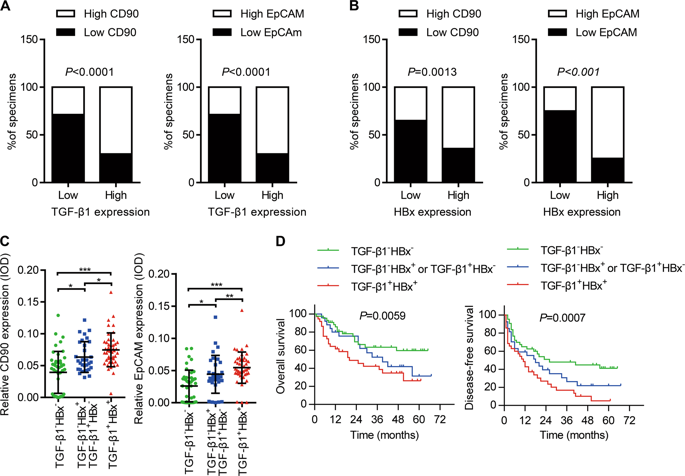Our official English website, www.x-mol.net, welcomes your
feedback! (Note: you will need to create a separate account there.)
TGF-β1 accelerates the hepatitis B virus X-induced malignant transformation of hepatic progenitor cells by upregulating miR-199a-3p.
Oncogene ( IF 6.9 ) Pub Date : 2019-11-18 , DOI: 10.1038/s41388-019-1107-9 Ke-Shuai Dong 1, 2 , Yan Chen 3 , Guang Yang 1 , Zhi-Bin Liao 1 , Hong-Wei Zhang 1 , Hui-Fang Liang 1 , Xiao-Ping Chen 1 , Han-Hua Dong 1
Oncogene ( IF 6.9 ) Pub Date : 2019-11-18 , DOI: 10.1038/s41388-019-1107-9 Ke-Shuai Dong 1, 2 , Yan Chen 3 , Guang Yang 1 , Zhi-Bin Liao 1 , Hong-Wei Zhang 1 , Hui-Fang Liang 1 , Xiao-Ping Chen 1 , Han-Hua Dong 1
Affiliation

|
Increasing evidence has suggested that liver cancer arises partially from transformed hepatic progenitor cells (HPCs). However, the detailed mechanisms underlying HPC transformation are poorly understood. In this study, we provide evidence linking the coexistence of hepatitis B virus X protein (HBx) and transforming growth factor beta 1 (TGF-β1) with miR-199a-3p in the malignant transformation of HPCs. The examination of liver cancer specimens demonstrated that HBx and TGF-β1 expression was positively correlated with epithelial cell adhesion molecule (EpCAM) and cluster of differentiation 90 (CD90). Importantly, EpCAM and CD90 expression was much higher in the specimens expressing both high HBx and high TGF-β1 than in those with high HBx or high TGF-β1 and the double-low-expression group. HBx and TGF-β1 double-high expression was significantly associated with poor prognosis in primary liver cancer. We also found that HBx and TGF-β1 induced the transformation of HPCs into hepatic cancer stem cells and promoted epithelial-mesenchymal transformation, which was further enhanced by concomitant HBx and TGF-β1 exposure. Moreover, activation of the c-Jun N-terminal kinase (JNK)/c-Jun pathway was involved in the malignant transformation of HPCs. miR-199a-3p was identified as a significantly upregulated microRNA in HPCs upon HBx and TGF-β1 exposure, which were shown to promote miR-199a-3p expression via c-Jun-mediated activation. Finally, we found that miR-199a-3p was responsible for the malignant transformation of HPCs. In conclusion, our results provide evidence that TGF-β1 cooperates with HBx to promote the malignant transformation of HPCs through a JNK/c-Jun/miR-199a-3p-dependent pathway. This may open new avenues for therapeutic interventions targeting the malignant transformation of HPCs in treating liver cancer.
中文翻译:

TGF-β1 通过上调 miR-199a-3p 加速乙型肝炎病毒 X 诱导的肝祖细胞恶性转化。
越来越多的证据表明,肝癌部分源于转化的肝祖细胞 (HPC)。然而,人们对 HPC 转换背后的详细机制知之甚少。在这项研究中,我们提供了将乙型肝炎病毒 X 蛋白 (HBx) 和转化生长因子 β1 (TGF-β1) 与 miR-199a-3p 共存与 HPC 恶性转化联系起来的证据。肝癌标本的检查表明HBx和TGF-β1表达与上皮细胞粘附分子(EpCAM)和分化簇90(CD90)呈正相关。重要的是,与高 HBx 或高 TGF-β1 和双低表达组相比,EpCAM 和 CD90 表达在同时表达高 HBx 和高 TGF-β1 的标本中要高得多。HBx和TGF-β1双高表达与原发性肝癌的不良预后显着相关。我们还发现 HBx 和 TGF-β1 诱导 HPCs 转化为肝癌干细胞并促进上皮间充质转化,同时 HBx 和 TGF-β1 暴露进一步增强了这种转化。此外,c-Jun N-末端激酶(JNK)/c-Jun 通路的激活参与了 HPC 的恶性转化。在暴露于 HBx 和 TGF-β1 后,miR-199a-3p 被鉴定为 HPC 中显着上调的 microRNA,其显示通过 c-Jun 介导的激活促进 miR-199a-3p 表达。最后,我们发现 miR-199a-3p 负责 HPC 的恶性转化。综上所述,我们的研究结果提供证据表明 TGF-β1 与 HBx 协同通过 JNK/c-Jun/miR-199a-3p 依赖性途径促进 HPC 的恶性转化。这可能为针对 HPC 恶性转化治疗肝癌的治疗干预开辟新途径。
更新日期:2019-11-18
中文翻译:

TGF-β1 通过上调 miR-199a-3p 加速乙型肝炎病毒 X 诱导的肝祖细胞恶性转化。
越来越多的证据表明,肝癌部分源于转化的肝祖细胞 (HPC)。然而,人们对 HPC 转换背后的详细机制知之甚少。在这项研究中,我们提供了将乙型肝炎病毒 X 蛋白 (HBx) 和转化生长因子 β1 (TGF-β1) 与 miR-199a-3p 共存与 HPC 恶性转化联系起来的证据。肝癌标本的检查表明HBx和TGF-β1表达与上皮细胞粘附分子(EpCAM)和分化簇90(CD90)呈正相关。重要的是,与高 HBx 或高 TGF-β1 和双低表达组相比,EpCAM 和 CD90 表达在同时表达高 HBx 和高 TGF-β1 的标本中要高得多。HBx和TGF-β1双高表达与原发性肝癌的不良预后显着相关。我们还发现 HBx 和 TGF-β1 诱导 HPCs 转化为肝癌干细胞并促进上皮间充质转化,同时 HBx 和 TGF-β1 暴露进一步增强了这种转化。此外,c-Jun N-末端激酶(JNK)/c-Jun 通路的激活参与了 HPC 的恶性转化。在暴露于 HBx 和 TGF-β1 后,miR-199a-3p 被鉴定为 HPC 中显着上调的 microRNA,其显示通过 c-Jun 介导的激活促进 miR-199a-3p 表达。最后,我们发现 miR-199a-3p 负责 HPC 的恶性转化。综上所述,我们的研究结果提供证据表明 TGF-β1 与 HBx 协同通过 JNK/c-Jun/miR-199a-3p 依赖性途径促进 HPC 的恶性转化。这可能为针对 HPC 恶性转化治疗肝癌的治疗干预开辟新途径。











































 京公网安备 11010802027423号
京公网安备 11010802027423号